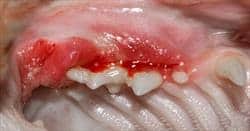
Feline dental care is perhaps the most overlooked and under-treated area in small animal medicine. Cats are affected by many of the same dental problems that affect dogs and people, including periodontal diseases, fractured teeth, and oral tumors. Cats are also plagued with their own unique issues such as tooth resorption and inflammation.
Resorption of Teeth
More than half of cats over three years old have tooth resorption(s) (TR). These tooth defects have also been called cavities, neck lesions, external or internal root resorptions, FORLs and cervical line erosions. Affected tooth roots often erode and disappear when they are replaced by bone. The lower third premolars and molars are most commonly affected; however, tooth resorptions can be found on any tooth. The specific cause for tooth resorption in cats (and dogs) is unknown, but theories supporting an autoimmune response have been proposed.
Cats affected with tooth resorption may show excessive salivation, bleeding in the mouth, or have difficulty eating. Tooth resorptions can be quite painful but many affected cats hide their pain. Most times it is up to the veterinarian to diagnose tooth resorption on oral examination with x-rays.

Treating a tooth resorption can involve extracting the affected tooth.
Stomatitis
Cats can also be affected by stomatitis, an inflammatory condition. The cause of this disease has not been determined but an immune-related cause is suspected.

Signs in an affected cat include bad breath, difficulty swallowing, weight loss, and excessive salivation. X-rays often reveal moderate to severe periodontal disease with bone loss.
Managing a case of stomatitis can be challenging. Oftentimes extracting specific or all the teeth resolves the syndrome in 60 percent of the cases. The remaining 40 percent also require life-long medication to be comfortable.
Fractured Teeth
Some cats have fractured teeth from cat fights and other forms of external trauma. The canines are most commonly affected. Fractured teeth are commonly sensitive because the nerve is exposed. Even if the nerve is not exposed the affected tooth can be sensitive. Just as in people, root canal therapy or extraction is the needed treatment.

Oral Masses (cancer)
Cats are also affected by cancer in their mouths. Squamous cell carcinoma is the most common type of oral cancer. Less common feline oral malignancies include melanoma, fibrosarcoma, lymphosarcoma, and undifferentiated carcinomas. Not all feline oral swellings are malignant Biopsies are essential for diagnosis.
Cats can be affected by many oral and dental conditions, which once diagnosed and treated help them live are pain-free and happily!

